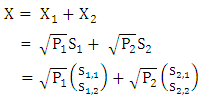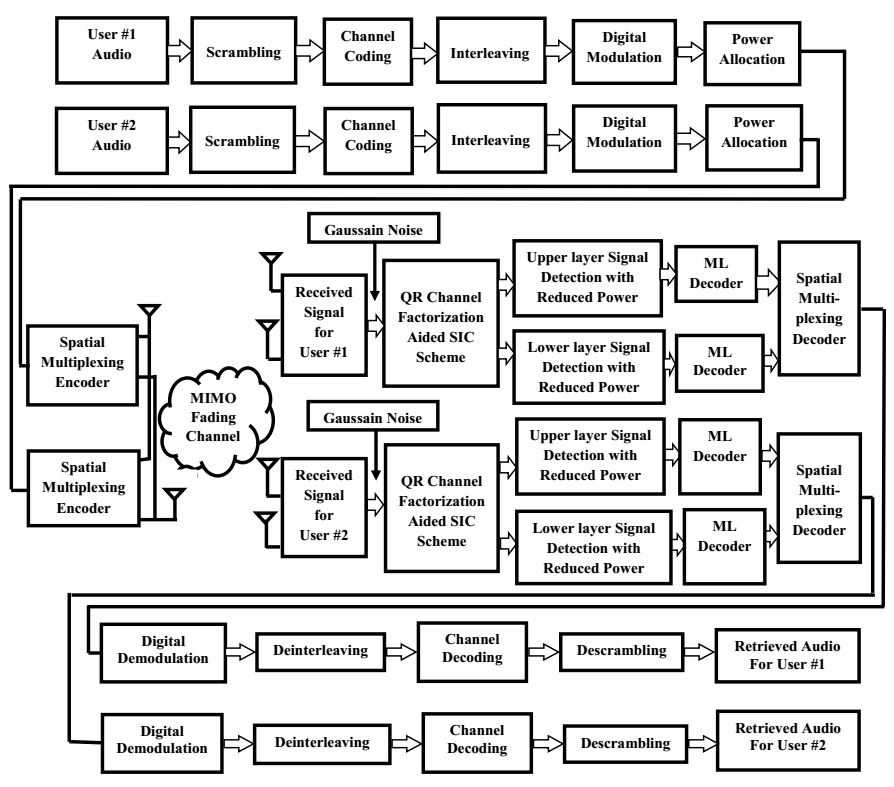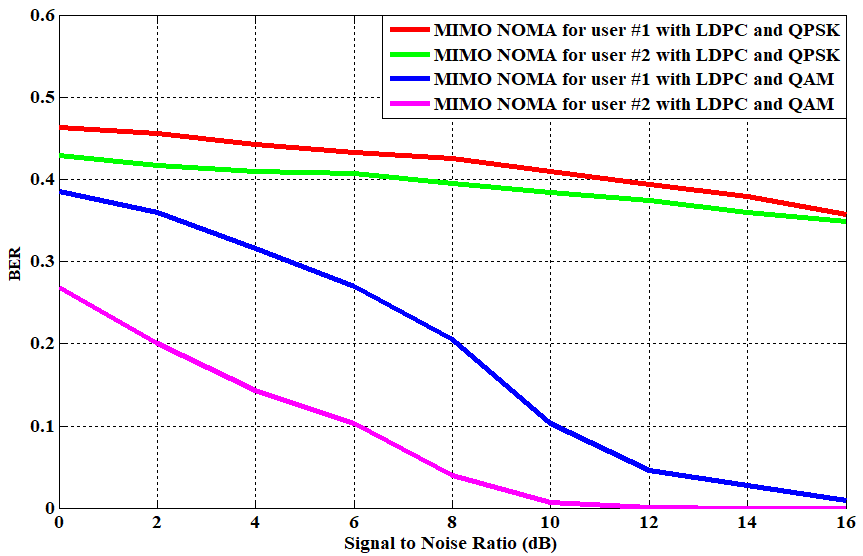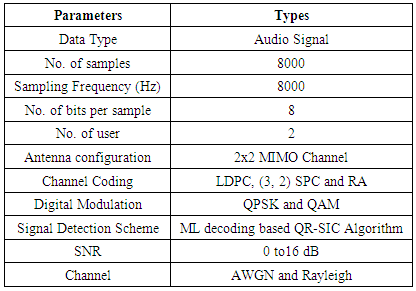-
Paper Information
- Paper Submission
-
Journal Information
- About This Journal
- Editorial Board
- Current Issue
- Archive
- Author Guidelines
- Contact Us
International Journal of Networks and Communications
p-ISSN: 2168-4936 e-ISSN: 2168-4944
2018; 8(4): 97-105
doi:10.5923/j.ijnc.20180804.01

Secured Voice Frequency Signal Transmission in 5G Compatible Multiuser Downlink MIMO NOMA Wireless Communication System
Md. Humaun Kabir1, Jinia Rahman2, Shaikh Enayet Ullah2
1Department of Computer Science and Engineering, Pundra University of Science and Technology, Bogura, Bangladesh
2Department of Applied Physics and Electronic Engineering, University of Rajshahi, Rajshahi, Bangladesh
Correspondence to: Md. Humaun Kabir, Department of Computer Science and Engineering, Pundra University of Science and Technology, Bogura, Bangladesh.
| Email: |  |
Copyright © 2018 The Author(s). Published by Scientific & Academic Publishing.
This work is licensed under the Creative Commons Attribution International License (CC BY).
http://creativecommons.org/licenses/by/4.0/

In this paper, we investigate the performance of 2×2 multi antenna configured NOMA wireless communication system. The simulated system under investigation incorporates various types of channel coding schemes (LDPC, (3, 2) SPC and Repeat and Accumulate) and two types of low order modulation techniques (QPSK and QAM). We propose an improved ML decoding based QR channel factorization aided SIC (QR-SIC) technique and it is implemented on encrypted audio signal transmission in a hostile fading channel. Numerical simulation results show that the presently considered simulated system is very much robust and effective in retrieving audio signal under utilization of Repeat and Accumulate channel coding and QAM digital modulation techniques.
Keywords: 5G, NOMA, MIMO, QR-SIC, ML decoding, LDPC, (3, 2) SPC and RA
Cite this paper: Md. Humaun Kabir, Jinia Rahman, Shaikh Enayet Ullah, Secured Voice Frequency Signal Transmission in 5G Compatible Multiuser Downlink MIMO NOMA Wireless Communication System, International Journal of Networks and Communications, Vol. 8 No. 4, 2018, pp. 97-105. doi: 10.5923/j.ijnc.20180804.01.
Article Outline
1. Introduction
- In view of consideration of increasing demand by mobile radio customers for multimedia services, higher data rates andbandwidth availability as well as anticipated traffic related to the Internet of Things (IoT), the fifth Generation (5G) /Beyond 5G (B5G) wireless communication systems will emerge to meet up unprecedented demands beyond the capability of previous generations of wireless communication networks. The 5G networks will promote the continued evolution of the way human interacting information and provide users with ultimate experience through more immersive services such as 3D connectivity (aircraft and drone), Ultra High Definition (UHD), 3D video, Online gaming applications, Augmented and virtual reality, Video/photo sharing in stadium/open air gathering, Mobile cloud/desktop cloud, Tactile Internet, Collaborative robots etc. [1-2]. OFDMA is commonly used as the multiple access technique in the present wireless communication systems which can provide concurrent interference free transmission to multiple users with orthogonal subcarriers. The main drawback of OFDMA is that it does not generally achieve the highest possible data rate for a given error probability [3-6]. Non-orthogonal multiple access (NOMA) technology has been considered as a state-of-the-arttechnology which can achieve higher spectrum efficiency and support more massive connectivity as compared to the traditional orthogonal multiple access techniques. Many mainstream companies have proposed NOMA for the fifth generation (5G) wireless communication standard. For downlink NOMA, non-orthogonality is achieved by introducing the power domain, either in time/frequency/code domains, for user multiplexing. User de-multiplexing is obtained through the allocation of a large power difference between the users on the transmitter side and the application of SIC on the receiver side [7]. Four categories of NOMA such as scrambling-based NOMA, spreading-based NOMA, coding-based NOMA, and interleaving-based NOMA have been suggested and their performance acceptability has also been studied at [8]. Energy harvesting technology implemented wireless powered communication networks (WPCNs) have been envisioned as a promising solution for the future Internet-of-Things (IoT). The NOMA has been recently considered for the uplink of WPCNs based IoT networks with a massive number of devices. In scenario of total energy consumption and maximization of spectral efficiency, a comprehensive study was conducted on both NOMA-based WPCN (N-WPCN) and TDMA-based WPCN (T-WPCN) at [9]. Now a days, a paramount importance is being given on integrating NOMA to unmanned aerial vehicle (UAV)-aided wireless communication networks for achieving high spectral efficiency (SE). In [10], the authors introduced NOMA transmission under consideration of user distances as the available feedback, to UAVs serving as aerial base stations (BSs). Through their extensive simulation works, a comprehensive framework was developed for deriving achievable outage probabilities and sum rates rigorously with implementation of distance feedback based NOMA strategy. NOMA technique can be applied to improve the achievable sum rate of multiple-input multiple-output (MIMO)-based multi-user visible light communication (VLC) systems. At [11], the authors proposed a normalized gain difference power allocation (NGDPA) method first through exploiting users' channel conditions for consideration of efficient and low-complexity power allocation in indoor MIMO-NOMA-based VLC systems. With employment of NOMA with the proposed NGDPA method, achievable sum rate of the 2×2 MIMO-VLC system was improved significantly. In [12], the authors made investigative study on the performance of advanced NOMA using experimental trials in outdoor using 22 open loop MIMO and 42 closed-loop MIMO. The results of their work confirmed that NOMA was capable of providing a maximum of 2.3 times more gains as compared to SU-MIMO for the case of 3-UE when combined with 42 closed-loop MIMO. At [13], the authors investigated on the joint power allocation and modulation optimization in two-user NOMA channels using finite-alphabet inputs with perfect CSI. Their simulation results showed that their proposed approach based on the error-rate criterion outperformed as compared to some existing NOMA schemes based on perfect SIC assumption. In [14], the authors utilized cyclostationarity based equalization scheme in power domain NOMA system for signal detection. Results of their simulation works confirmed the suitability of implemented technique in under low signal-to-noise ratio (SNR) environment. In this present study, we have presented simulation results for MIMO NOMA system under scenario of utilizing mainly encryption, different modulation, several channel coding, and successive user interference reductions techniques.
2. Signal Processing Techniques
- In our present study various signal processing schemes have been used. A brief overview of these schemes is given below:
2.1. ML Decoding Based QR-SIC Algorithm
- We assume that the base station is equipped with M transmitting antennas and each individual user is equipped with Nreceiving antennas (M ≤ N). With perfect channel state information (H), the received signal at
 user can be represented as:
user can be represented as: | (1) |
 is the complex channel coefficient between
is the complex channel coefficient between  user and base station,
user and base station,  is the allocated power for the
is the allocated power for the  user,
user,  is the transmitted symbol for
is the transmitted symbol for  user from
user from  transmitting antenna and the term
transmitting antenna and the term  denotes the receiver Gaussian noise including inter-cell interference at the receiver of
denotes the receiver Gaussian noise including inter-cell interference at the receiver of  user. For the case of two users (k = 1, 2), assume that
user. For the case of two users (k = 1, 2), assume that  is a cell-center user (near user) and
is a cell-center user (near user) and  is a cell-edge user (far user), the received signals at user #1 and user #2 are given by:
is a cell-edge user (far user), the received signals at user #1 and user #2 are given by: | (2) |
 | (3) |
 | (4) |
 and
and  are transmitted signals for
are transmitted signals for  and
and  prior to power allocation, signal components S1,1 of
prior to power allocation, signal components S1,1 of  and S2,1 of UE2 are transmitted from first transmitting antenna and S1,2 of
and S2,1 of UE2 are transmitted from first transmitting antenna and S1,2 of  and S2,2 of UE2 are transmitted from second transmitting antenna. The
and S2,2 of UE2 are transmitted from second transmitting antenna. The  (20% of total power) and
(20% of total power) and  (80% of total power) are allocated power to user #1 and user #2 respectively. On QR matrix decomposition of channel coefficient of
(80% of total power) are allocated power to user #1 and user #2 respectively. On QR matrix decomposition of channel coefficient of  user, we can write,
user, we can write, | (5) |
 is N×M unitary matrix,
is N×M unitary matrix, 
 is M×M upper triangular matrix. After multiplying both sides of equation (1) with complex conjugate transformed of
is M×M upper triangular matrix. After multiplying both sides of equation (1) with complex conjugate transformed of  , we get:
, we get: | (6) |
 | (7) |
 is indicative of square of Frobenius norm of matrix,
is indicative of square of Frobenius norm of matrix,  is the
is the  component of R and
component of R and  implies the absolute value [15-16].
implies the absolute value [15-16].2.2. LDPC Channel Coding
- Low-density parity-check (LDPC) code invented by Gallager is a linear block code with its parity-check matrix H containing only a few 1’s in comparison to 0’s. Bilateral Tanner graph is used to make graphical representation of LDPC codes. In bilateral Tanner graph, nodes are grouped into one set of n bit nodes (or variable nodes) and the other set of m check nodes (or parity nodes). Check node i is connected to bit node j in case of any elemental value of the parity matrix unity. The decoding operates alternatively on the bit nodes and the check nodes to find the most likely codeword c that satisfies the condition cHT= 0. In iterative Log Domain Sum-Product LDPC decoding in AWGN noisy channel environment of variance σ2 and received signal vector r, the log-likelihood ratios (LLRs) instead of probability can be defined as:
 | (8) |
 | (9) |
 is updated as:
is updated as: | (10) |
 The function is defined as:
The function is defined as: | (11) |
 | (12) |
 | (13) |
 | (14) |
2.3. Repeat and Accumulate (RA) Channel Coding
- The RA is a powerful modern error-correcting channel coding scheme. In such channel coding scheme, all the extracted binary bits from the audio has been arranged into a single block and the binary bits of such block is repeated 2 times and rearranged into a single block containing binary data which is double of the number of input binary data.
2.4. (3, 2) Single Parity Check Channel Coding
- In (3, 2) Single Parity Check (SPC) channel coding scheme, the binary bits are grouped into very small sized message block u consisting of two consecutive bits. The code is generated with addition of a single parity bit to the message u = [u0, u1] so that the elements of the resulting code word x = [x0, x1, x2] are given by x0 = u0, x1 = u1 and x2 = u0 Ξ u1 where, the symbol Ξ used here is indicative of the sum over GF (2) [19].
2.5. Data Scrambling
- The transmitted voice frequency signals are encrypted in this simulation work for secured communication. The binary converted data from audio signal of each of the two users are grouped individually with each group containing 1 byte (8 bits) binary data. Each grouped binary data as plain text are encrypted with identical secret key of bit length 8 through performing XOR operation to produce encrypted/scrambled binary data [20].
3. System Model
- The conceptual block diagram of the downlink multiuser MIMO NOMA wireless communication system is shown in Figure 1. In such system, both BS and users are equipped with 2 antennas. For convenience, we assume that user #1 is sufficiently close to the BS, while user #2 is not close to the BS (e.g., a cell-edge user). The BS usually allocates a high transmission power to comparatively far user and a low transmission power to near user. In this simulation work, 20% of the total power is used for user #1 and remaining 80% is for user #2. Thus, user #1 decodes the signal for user#2 first and then decodes his/her signal after subtracting the decoded signal of user #2. At terminal of user #2, the signal of user #2 can be decoded without significant interference from the signal of user #1. A segment of digitally recorded audio signal is considered as input data for each user. The sampled analog values of audio signal are converted into corresponding integer values under consideration of 256 quantization levels. The extracted binary bits in 0/1 format are encrypted and channel encoded using LDPC, (3, 2) SPC and Repeat & Accumulate coding schemes and then are digitally modulated using QPSK and QAM. The digitally modulated complex symbols are fed into spatial multiplexing encoder section for production of two independent data series for two users to be transmitted simultaneously from each of the two antennas after proper power allocation. In receiving section, all the transmitted signals are detected with QR channel factorization aided SIC scheme with implementation of ML decoding and the detected signals are subsequently sent up to spatial multiplexing decoder. The multiplexed symbols are digitally demodulated, deinterleaved, channel decoded and decrypted to recover the transmitted audio signals.
 | Figure 1. Block diagram of 5G compatible multiuser downlink MIMO NOMA wireless communication system |
4. Results and Discussion
- In this section, we present a series of simulation results using MATLAB to illustrate the significant impact of various types of channel coding and modulation techniques on MIMO NOMA Wireless Communication system performance in terms of bit error rate (BER). It is assumed that the channel state information (CSI) of MIMO fading channel is available at the receiver. The proposed model is simulated to evaluate the quality of the system performance with considering the following parameters presented in the Table 1.
|
 | Figure 2. BER performance of LDPC channel encoded MIMO NOMA Wireless communication system with QPSK and QAM digital modulation scheme for audio data transmission |
 | Figure 3. BER performance of (3, 2) SPC channel encoded MIMO NOMA Wireless communication system with QPSK and QAM digital modulation scheme for audio data transmission |
 | Figure 4. BER performance of Repeat and Accumulate channel encoded MIMO NOMA Wireless communication system with QPSK and QAM digital modulation scheme for audio data transmission |
5. Conclusions
- In this paper, a comprehensive study has been undertaken on the performance evaluation of MIMO NOMA wireless communication system for transmission of secured audio signal. Numerical results ratifies the significance of exploiting digital modulation, ML decoding based QR channel factorization aided SIC (QR-SIC)and different channel coding schemes. In the context of system performance, it can be concluded that the implementation of QAM digital modulation technique in Repeat and Accumulate channel coding scheme provides satisfactory result for such a 5G compatible downlink multiuser MIMO NOMA Wireless Communication System.
 Abstract
Abstract Reference
Reference Full-Text PDF
Full-Text PDF Full-text HTML
Full-text HTML



